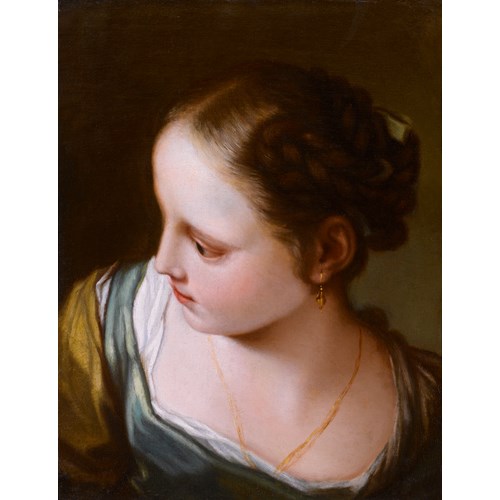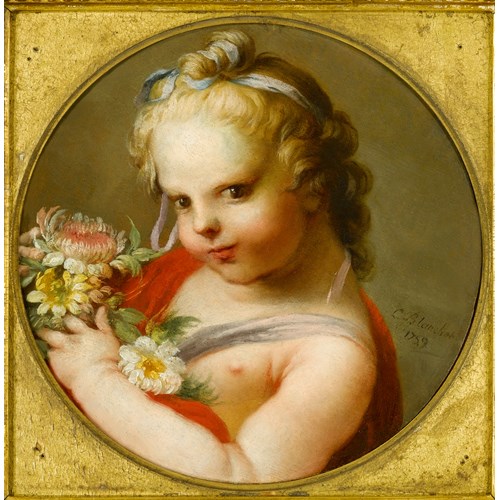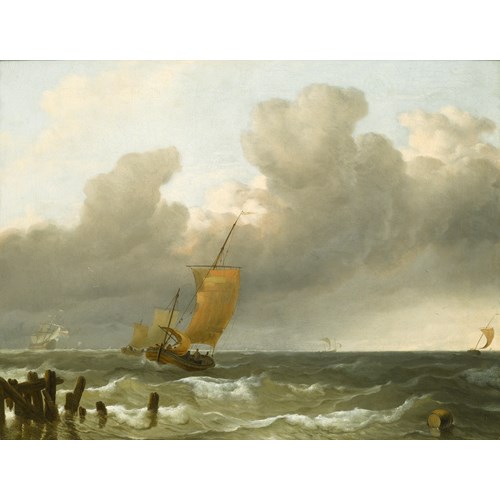Marketplace
Caucasian Landscape
Paul von Franken
Caucasian Landscape
Date 1866
Period 1850-1900, 19th century
Origin Germany
Medium Oil on canvas
Dimension 38.5 x 56 cm (15¹/₈ x 22 inches)
Caucasian Landscape shows a hill-top village in the Caucasian mountain range. At the top of the village, a tower rises from the citadel, whilst further down the stone dwellings and concentric fortifications appear to have fallen into a dilapidated state. The village and surrounding area is abundant with trees and bushes, often dispersed and growing amongst the buildings. In the foreground two figures sit below a tree, whilst two villagers standing look on. To their right a handful of sheep can be seen grazing in the shrubbery, whilst the black outline of two figures are seen walking near to a red-domed building on the outskirts of the village.
This painting, completed just two years after the end of the war where parts of the Northern Caucasus seceded to Russia, suggests that the village is no longer fully occupied. There is a distinct quietness, with very little apparent activity. It is possible that this village, having suffered during the long conflict with the Russia, has been deserted and fallen into a state of disrepair, with only a handful of inhabitants remaining. Whilst direct sunlight is cast over the buildings in the left-foreground, the majority of the village is shaded and the palette becomes darker the higher the mountain reaches, suggesting that this is the last of the early evening sun before nightfall.
Paul von Franken was fascinated by the culture of the Caucasus after he spent eight years living in Tiflis (1853-1861) during the Russian invasion and military conflict. The lengthy war, initiated by three Russian Tsars: Alexander I, Nicholas I and Alexander II, comprised of military actions waged by Russia against territories and tribal groups in the Caucasus as Russia sought to expand southward. One of the consequences of Russian occupation was the forced exodus and expulsion of many of the indigenous peoples from their villages. The expulsion was launched before the end of the war in 1864 and it continued into the 1870s, although it was mostly completed by 1867. The Caucasians, who were predominantly Muslim, were given the choice either to convert to Christianity and resettle in other Russian lands or to be transferred to the Ottoman Empire. Very few chose to remain in Russia and were rounded up along the Black Sea coast where boats waited to transport them to the neighbouring Ottoman Empire.
In 1864 the Main Staff of the Caucasian Army said ‘A deed has been accomplished almost without precedent in history: not one of the mountaineer inhabitants remains on their former places of residence, and measures are being taken to cleanse the region in order to prepare it for the new Russian population’. With this in mind, Caucasian Landscape encapsulates the abandonment of local villages throughout the Northern Caucasus.
Von Franken, a genre and landscape painter, was born in 1819 in Oberbachem near Godesberg. He trained at the Düsseldorf Academy of Arts, and spent the period 1842-1845 in Brussels and Antwerp, exhibiting at the Dresden Academy in 1846. With his Latvian wife, von Franken moved to Tiflis in 1853. Despite returning to work in Düsseldorf in 1861, von Franken frequently returned to the Tiflis and the Caucasus to paint and draw, taking the images and inspiration from Georgia back to his studio in Germany.
This painting, completed just two years after the end of the war where parts of the Northern Caucasus seceded to Russia, suggests that the village is no longer fully occupied. There is a distinct quietness, with very little apparent activity. It is possible that this village, having suffered during the long conflict with the Russia, has been deserted and fallen into a state of disrepair, with only a handful of inhabitants remaining. Whilst direct sunlight is cast over the buildings in the left-foreground, the majority of the village is shaded and the palette becomes darker the higher the mountain reaches, suggesting that this is the last of the early evening sun before nightfall.
Paul von Franken was fascinated by the culture of the Caucasus after he spent eight years living in Tiflis (1853-1861) during the Russian invasion and military conflict. The lengthy war, initiated by three Russian Tsars: Alexander I, Nicholas I and Alexander II, comprised of military actions waged by Russia against territories and tribal groups in the Caucasus as Russia sought to expand southward. One of the consequences of Russian occupation was the forced exodus and expulsion of many of the indigenous peoples from their villages. The expulsion was launched before the end of the war in 1864 and it continued into the 1870s, although it was mostly completed by 1867. The Caucasians, who were predominantly Muslim, were given the choice either to convert to Christianity and resettle in other Russian lands or to be transferred to the Ottoman Empire. Very few chose to remain in Russia and were rounded up along the Black Sea coast where boats waited to transport them to the neighbouring Ottoman Empire.
In 1864 the Main Staff of the Caucasian Army said ‘A deed has been accomplished almost without precedent in history: not one of the mountaineer inhabitants remains on their former places of residence, and measures are being taken to cleanse the region in order to prepare it for the new Russian population’. With this in mind, Caucasian Landscape encapsulates the abandonment of local villages throughout the Northern Caucasus.
Von Franken, a genre and landscape painter, was born in 1819 in Oberbachem near Godesberg. He trained at the Düsseldorf Academy of Arts, and spent the period 1842-1845 in Brussels and Antwerp, exhibiting at the Dresden Academy in 1846. With his Latvian wife, von Franken moved to Tiflis in 1853. Despite returning to work in Düsseldorf in 1861, von Franken frequently returned to the Tiflis and the Caucasus to paint and draw, taking the images and inspiration from Georgia back to his studio in Germany.
Date: 1866
Period: 1850-1900, 19th century
Origin: Germany
Medium: Oil on canvas
Signature: Signed and dated ‘PVFranken/ 1866’ (lower right).
Dimension: 38.5 x 56 cm (15¹/₈ x 22 inches)
More artworks from the Gallery









